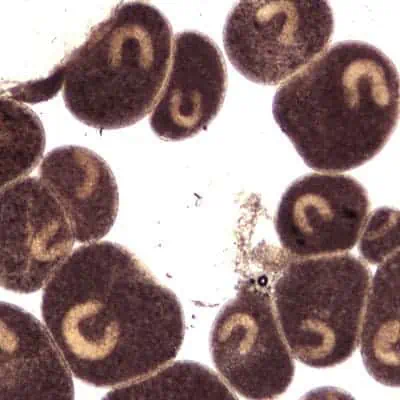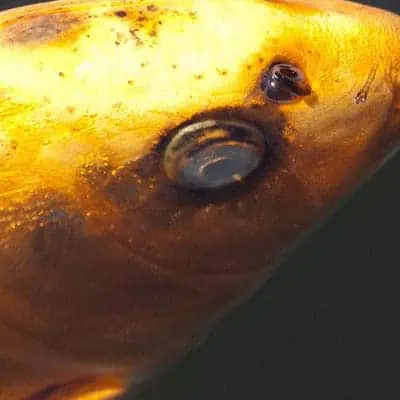Koi, and a variety of other pond fish including goldfish and even pumpkinseed fish, can on occasion suffer from an ailment known as cloudy eye. Eyes may appear slightly clouded over or almost completely opaquely white.
Often referred to as “cloudy eye disease,” it is not actually itself a disease, but rather is symptomatic of something else going on, such as a bacterial or parasitic infection, and fish should be treated immediately at the first sign of symptoms.
What Is Cloudy Eye? Where Does It Come From?

Cloudy eyes are often a symptom of a more serious condition – afflictions that can cause cloudy eye include: ich, white spot disease, skin or eye flukes, cataracts, malnutrition or dietary deficiencies, and fungal or bacterial infections in existing wounds.
In the case of parasites, bacteria, and fungal infections, inadequate water quality is often the primary instigator. Sometimes, these can be brought in by new fish; for this reason, any newly obtained fish should be quarantined for several days to monitor them for any diseases or infections that could spread to the rest of your pond.
Is Cloudy Eye Dangerous? Does it Need Treatment?
If only one eye is cloudy, it’s likely the fish simply smashed into something and injured its eye. Treatment may be necessary, but should clear up in a few days or so. In the case of older fish, it’s possible that they may simply have cataracts.
If both eyes are cloudy, and particularly if multiple fish are suffering from cloudy eyes, there is widespread issue, most likely bacterial, which should be diagnosed and treated immediately. To help determine this, you can take some water samples from your pond as well as light skin scrapings from fish and assess them under a microscope.
What Are Symptoms of Cloudy Eye?
Below are the most common symptoms that accompany cloudy eye in fish. If you’re still not certain if that’s the issue that your fish is suffering from, the United States Geological Survey utilizes this guide to assess and sample ailments in wild fish.

1) Opaque Film on Eye
The most obvious symptom of cloudy eye is, well, cloudy eyes. This will appear as a white or greyish film over the eye(s), usually over the surface of the cornea but it can extend deeper as well in more serious cases.
2) Excess Mucous Production
Just as with other animals, fish produce mucous to protect their eyes. If they’re suffering from cloudy eye, this typically involves excess mucous production that may be yellowish in color if the body is attempting to fight off an infection.
3) Difficulty Swimming and Feeding
Fish suffering from cloudy eye can’t see as well, and may display erratic and unusual swimming behavior as a result. They may also have a hard time feeding, as they cannot see the food as easily and the depth perception required to nab food is thrown off. If you notice unusual swimming and feeding behaviors, check your fish for cloudy or even just slightly opaque corneas.
4) Skin Irritation
As cloudy eyes are typically caused by poor water quality and, resultantly, bacteria or parasites, fish with cloudy eye may also have skin irritation. Skin may appear pink or red in areas, there could be some swelling, abrasions, and you might notice your fish trying to scratch itself against rocks, walls, plants, and so forth. Parasitic, bacterial, or fungal infections that are allowed to progress for too long can result in cloudy eye developing, so do treat your fish/pond immediately.
5) Weight Loss
Cloudy eye can be caused by infections, parasites, or malnutrition, all of which can also result in weight loss and lethargy.
6) Dull and Damaged Scales
Again, as cloudy eye is often caused by bacterial or fungal infections, parasites, or malnutrition, these all deplete the body’s resources and may instigate your koi’s scales dulling in color. Scales can also fall off, in more serious cases.
How to Treat Cloudy Eye in Koi, Goldfish & Ponds (Best Treatments)
1) Broad Spectrum Treatment (MinnFinn)
If you’re uncertain as to the exact cause of your koi’s cloudy eye, you can treat your pond with a broad spectrum treatment such as MinnFinn. MinnFinn is able to treat a variety of flukes, parasites, and fungal and bacterial infections. Check the label for more information here.
Its primary ingredient is hydrogen peroxide, resulting in less potential stress and harm to your fish than stronger, more chemical-laden treatments. It’s a good option to start with if you don’t know what the source of the problem is. If after a week the problem persists, it’s time to move onto a different approach.
2) Potassium Permanganate (Kusuri)
Stronger than MinnFinn but also capable of treating a wide variety of ailments, potassium permanganate can help resolve koi cloudy eye. It effectively chemically “burns off” fungus, parasites, and bacteria without overly damaging your koi’s skin or protective slime coating. It works particularly well against Ich, of which cloudy eyes is a known symptom.
3) Melaleuca Oil (Melafix)
- Contains one (1) API MELAFIX Freshwater Fish Bacterial Infection Remedy 64-Ounce Bottle
- Heals bacterial infections and repairs damaged fins, ulcers and open wounds
- Contains natural, botanical tea tree extract to quickly and rapidly help fish
Melafix, which contains natural melaleuca oil (tea-tree extract) as the main bactericide ingredient, is a good natural alternative to chemical treatments if the cloudy eye is bacterial or fungal and the symptoms are in the early stages. Melafix is unlikely to be enough for serve cloudy eye infections, but also works great as a follow-up treatment in the pond or quarantine tank during recovery after one of the other treatments listed here. It has very minimal impact on water quality, and is a good choice for early symptoms or for entire-pond (non-quarantine) dosing.
4) Copper Sulfate
Functioning as an insecticide, anti-parasitic, algaecide, fungicide, antibacterial, and molluscicide, copper sulfate is arguably the most effective chemical treatment option on this list, as it should eliminate any cloudy eye causes except food-related ones. However, it’s also the strongest and most potentially toxic chemical on this list, and should be used with great caution so as to not further damage fish or water quality.
5) Improve Water Quality
- Contains one (1) API POND MASTER TEST KIT Pond Water Test Kit 500-Test, including 6 bottles of testing solution, 3 color cards and 4 test...
- Helps monitor water quality and prevent invisible water problems that can be harmful to fish
- Measures ornamental pond pH balance, Ammonia content, Nitrite levels and Phosphate content
Poor water quality can reasonably be described as the ultimate root cause of cloudy eye. Therefore, water quality should be tested immediately if you notice your fish developing any potential symptoms of cloudy eye. The presence of chlorine, ammonia, nitrites, pH that is too low (below 6.4 means that you should probably perform water changes more regularly), and inadequate dissolved oxygen levels (above 7 ppm is best; below 6 ppm is a huge problem).
Make certain that you install a filter and aerator to your pond, use water conditioners as needed to eliminate chlorine, and perform small water changes daily or larger (up to 20%) changes weekly.
Incorporate a variety of submerged, emergent, and floating plants in your pond. These will naturally filter the water, provide oxygen, regulate water temperature via shading, and provide habitat for your fish as well as helpful invertebrates like mayfly larvae, which assist in ecosystem functioning and provide a natural food source for fish.
6) Provide Good Nutrition
A diet deficient in adequate nutrients make koi significantly more susceptible to a host of illnesses and diseases, and, as a result, cloudy eye. A koi’s diet should be composed of 35 to 40% protein from plant (such as wheat germ and spirulina) or meat based (such as bloodworms and shrimp) sources, depending on season or preference. No more than 10% of its diet should consist of carbohydrates, 5 to 10% lipids (this can increase to 15% in autumn and winter), and the proper balance of vitamins and minerals.
Check here for a list of our recommended koi feeds with the best quality ingredients and nutrition!






The koi eye as some sort of growth . Its looks like a flap of skin same colour as the fish you can only see a small black dot instead of a full eye . Can this be treated . At the moment im treating the wayer as its gone clowdy . Can i use the 2 treatments together if there is a treatment . And which is the treatment to get
I treated my water yesterday using potassium permanganate. The water stayed pinkish for at least an hour (I don’t know if it was longer as i was on a work call and couldn’t go back out and check for a bit.) The one affected fish’s eyes seemed to look less cloudy later that day, but today it was still not seemingly able to “see” it’s food (it just kept randomly opening it’s mouth until it got lucky.) Do I treat the water again with potassium permanganate? Or should I use something different? And how long should I wait until next treatment?